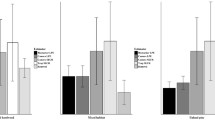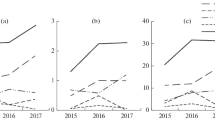Abstract
Edge effect is an inherent problem when using trapping grids to estimate density of small mammals, resulting in a sampling area larger than the area of the grid. Distances between captures of individuals are used to estimateA(W), the effective sampling area of a trapping grid, but grid size sets a limit for the largest detectable distance. The spool-and-line technique is proposed here as a new method to estimateA(W). Movement distances based on the spool-and-line technique were compared to similar movement distances based on capture-recapture of three species of marsupials of the Atlantic Forest of Brazil. Distances based on the two methods were uncorrelated, and only ln-transformed distances based on the spool-and-line were normally distributed. The maximum distance moved (MaxD) estimated by the spool-and-line was chosen as the more accurate and practical distance to estimate edge effect. Estimates of the effective sampling area and densities for the common opossumDidelphis aurita (Wied-Neuwied, 1826), were compared using MaxD based on spool-and-line (MaxDs p o o l ) , capture-recapture (MaxDcap), and also the distance between traps (DT). MaxDspool reflected more accurately density variation between seasons. Movement distances of small mammals based on the spool-and-line technique permit more accurate estimates of density and its dynamics.
Similar content being viewed by others
]References
Anderson D. R., Burnham K. P., White G. C. and Otis D. L. 1983. Density estimation of small-mammal populations using a trapping web and distance sampling methods. Ecology 64: 674–680.
Bergallo H. G. 1994. Ecology of a small mammal community in an Atlantic Forest area in Southeastern Brazil. Studies on Neotropical Fauna and Environment 29: 197–217.
Bergallo H. G. and Magnusson W. E. 1999. Effects of climate and food availability on four rodent species in Southeastern Brazil. Journal of Mammalogy 80: 472–486.
Bondrup-Nielsen S. 1983. Density as a function of live-trapping grid and home range size. Canadian Journal of Zoology 61: 2361–2365.
Boonstra R. and Craine I. T. M. 1986. Natal nest location and small mammals tracking with a spool and line technique. Canadian Journal of Zoology 64: 1034–1036.
Brant D. H. 1962. Measures of the movement and population densities of small rodents. University of California Publications in Zoology 62: 105–184.
Broughton S. K. and Dickman C. R. 1991. The effect of supplementary food on home range of the southern brown bandicoot,Isoodon obesulus (Marsupialia: Peramelidae). Australian Journal of Ecology 16:71–78.
Davis D. E. 1953. Analysis of home range from recapture data. Journal of Mammalogy 34: 352–358.
DeBlase A. F. and Martin R. E. 1981. Diet analysis. [In: A manual of mammalogy with keys to families of the world. A. F. DeBlase and R. E. Martin, eds]. 2nd ed. W. C. Brown Company Publishers, Dubogue, IA: 297–304.
Dimmerstein E., Oslon D. M., Graham D. J., Webster A. L., Primm S. A., Bookbinder M. P. and Ledec G. 1995. A conservation assessment of the terrestrial ecoregions of Latin America and the Caribbean. WWF & World Bank, Washington: 1–129.
Fitch H. S. and Shirer H. W. 1970. A radiotelemetric study of the spatial relationships in the opossum. The American Midland Naturalist 84: 170–186.
Freitas S. R. 1998. [Spatial and temporal variation in habitat structure, and microhabitat selection by small mammals in the Atlantic Forest]. MSc thesis, [National Museum of the Federal University of Rio de Janeiro], Rio de Janeiro: 1–168. [In Portuguese]
Gentile R. and Cerqueira R. 1995. Movement patterns of five species of small mammals in a Brazilian restinga. Journal of Tropical Ecology 11: 671–677.
Gurnell J. and Gipps J. H. W. 1989. Inter trap movement and estimating rodent densities. Journal of Zoology 217: 241–254.
Harestad A. S. and Bunnell F. L. 1979. Home range and body weight — a reevaluation. Ecology 60: 389–402.
Harris S., Cresswell W. J., Forde P. G., Trewhella W. J., Woollard T. and Wray S. 1990. Home range analysis using radio-tracking data: a review of problems and techniques particularly applied to the study of mammals. Mammal Review 20: 97–123.
Hawkins C. E. and MacDonald D. W. 1992. A spool-and-line method for investigating the movements of badgers,Meles meles. Mammalia 56: 322–325.
Johnson D. R., Nydegger N. C. and Smith G. W. 1987. Comparison of movement-based density estimates for townsend ground squirrels in southwestern Idaho. Journal of Mammalogy 68: 689–691.
Julien-Laferričre D. and Atramentowicz 1990. Feeding and reproduction of three didelphid marsupials in two Neotropical Forests (French Guiana). Biotropica 22: 404–415.
Kenward R. E., Clarke R. T., Hodder K. H. and Walls S. S. 2001. Density and linkage estimators of home range: nearest-neighbour clustering defines multinuclear cores. Ecology 82: 1905–1920.
Kie J. G., Baldwin J. A and Evans C. J. 1996. CALHOME: a program for estimating animal home ranges. Wildlife Society Bulletin 24: 342–344.
Krebs C. J. 1966. Demographic changes in fluctuating populations ofMicrotus californicus. Ecological Monographs 36: 239–273.
Malcolm J. R. 1995. Forest structure and the abundance and diversity of neotropical small mammals. [In: Forest canopies. M. D. Lowman and N. M. Nadkarni, eds]. Academic Press, San Diego: 179–197.
Mares M. A. and Ernest K. A. 1995. Population and community ecology of small mammals in a gallery forest of central Brazil. Journal of Mammalogy 76: 750–768.
Meffe G. K. and Carroll C. R. 1994. Principles of conservation biology. Sinauer Associates, Inc., Sunderland, MA: 1–600.
Miles M. A., Souza A. A. de and Póvoa M. M. 1981. Mammal tracking and nest location in Brazilian forest with an improved spool-and-line device. Journal of Zoology 195: 331–347.
Neave H. R. and Worthington P. P. 1988. Distribution-free tests. Unwin Hyman Ltd., Boston, MA: 1–430.
Nimer E. 1989. [Climatology of Brazil]. IBGE, [Department of Natural Resources and Environmental Studies], Rio de Janeiro: 1–421. [In Portuguese]
Onoyama K. and Saitoh T. 1991. Spool-and-line tracking of the vole,Clethrionomys rufocanus bedfordiae, with special reference to its home range. Honyurui Kagaku 30: 131–142. [In Japanese with English summary]
Otis D. L., Burnham K. P., White G. C. and Anderson D. R. 1978. Statistical inference from capture data on closed animal populations. Wildlife Monographs no. 62. The Wildlife Society, Lousville: 1–135.
Rademaker V. 2001. [Population ecology and reproduction ofDidelphis, with special emphasis inD. aurita in a disturbed area of Atlantic Forest in the Serra dos Órgnos, Guapimirim, RJ]. MSc thesis, [Federal University of Minas Gerais], Belo Horizonte: 1–46. [In Portuguese]
Rizzini C. T. 1979. [Treatise of phytogeography of Brazil: sociological and floristical aspects]. Hucitec Ltda. and [University of Sao Paulo Press], Sao Paulo: 1–374. [In Portuguese]
Ryser J. 1995. Activity, movement and home range of Virginia opossum (Didelphis virginiana) in Florida. Bulletin of the Florida Museum of Natural History 38: 177–194.
Santori R. T., Astúa de Moraes D. and Cerqueira R. 1995. Diet composition ofMetachirus nudicaudatus andDidelphis aurita (Marsupialia, Didelphoidea) in Southeastern Brazil. Mammalia 59: 511–516.
Seber G. A. F. 1973. Estimation of animal abundance and related parameters. Griffin, London: 1–506.
Slade N. A. and Russell L. A. 1998. Distances as indices to movements and home-range size from trapping records of small mammals. Journal of Mammalogy 79: 346–351.
Slade N. A. and Swihart R. K. 1983. Home range indices for the hispid cotton rat (Sigmod0on hispidus) in Northeastern Kansas. Journal of Mammalogy 64: 580–590.
Smith M. H., Gardner R. H., Gentry J. B., Kaufman D. W. and O’Farrell M. H. 1975. Density estimations of small mammal populations. [In: Small mammals: their productivity and population dynamics. F. B. Golley, K. Petrusewicz and L. Ryszkowski, eds]. Cambridge University Press, Cambridge: 25–53.
Sokal R. R. and Rohlf F. J. 1995. Biometry. 3rd ed. W. H. Freeman and Company, New York: 1–887.
SOS Mata Atlântica/INPE/ISA. 1998. [Atlas of the evolution of forest remnants and ecosystems associated with the Atlantic Forest Domain in the 1990–95 period]. SOS Mata Atlântica/INPE/ISA, Sao Paulo: 1–54. [In Portuguese]
Stickel L. F. 1954. A comparison of certain methods of measuring ranges of small mammals. Journal of Mammalogy 35: 1–15.
Sunquist M. E., Austad S. N. and Sunquist F. 1987. Movement patterns and home range in the common opossum (Didelphis marsupialis). Journal of Mammalogy 68: 173–176.
Tanaka R. 1972. Investigation into the edge effect by use of capture-recapture data in a vole population. Researches on Population Ecology 13: 127–151.
Tanaka R. 1980. Controversial problems in advanced research on estimating population densities of small rodents. Researches on Population Ecology 2: 1–67.
Van Horne B. 1982. Effective trapping area for live-trap grids. Journal of Mammalogy 63: 155–157.
Vieira E. M. and Baumgarten L. C. 1995. Daily activity patterns of small mammals in a cerrado area from central Brazil. Journal of Tropical Ecology 11: 255–262.
Wilson D. E., Cole F. R., Nichols J. D., Rudran R. and Foster M. S. 1996. Measuring and monitoring biological diversity: Standard methods for mammals. Smithsonian Institution Press, Washington, D.C.: 1–409.
Wilson K. R. and Anderson D. R. 1985. Evaluation of two density estimators of small mammal population size. Journal of Mammalogy 66: 13–21.
Worton B. J. 1989. Kernel methods for estimating the utilization distribution in home-range studies. Ecology 70: 164–168.
Author information
Authors and Affiliations
Corresponding author
Additional information
Assicate Editor was Joseph F. Merritt.
Rights and permissions
About this article
Cite this article
Mendel, S.M., Vieira, M.V. Movement distances and density estimation of small mammals using the spool-and-line technique. Acta Theriol 48, 289–300 (2003). https://doi.org/10.1007/BF03194169
Received:
Accepted:
Issue Date:
DOI: https://doi.org/10.1007/BF03194169




